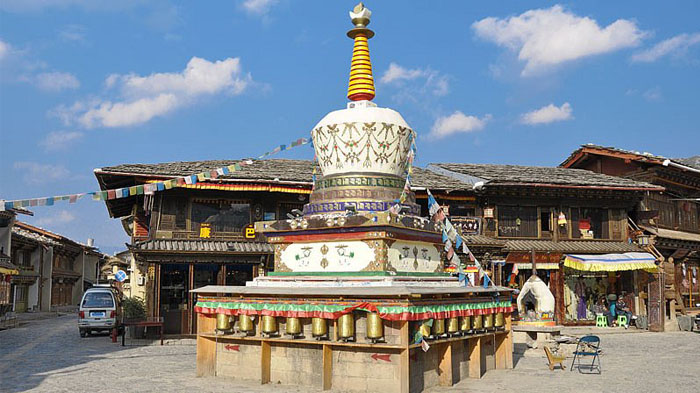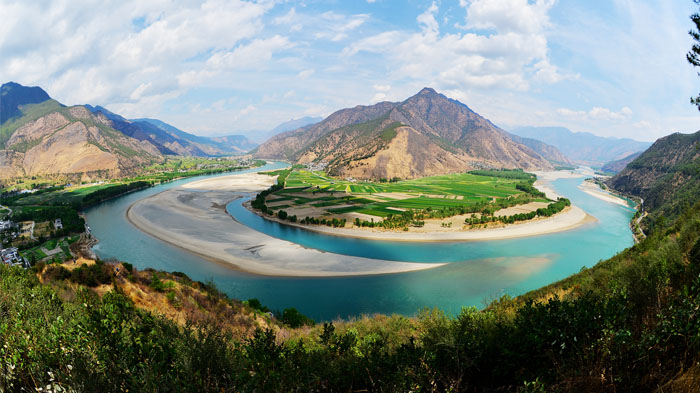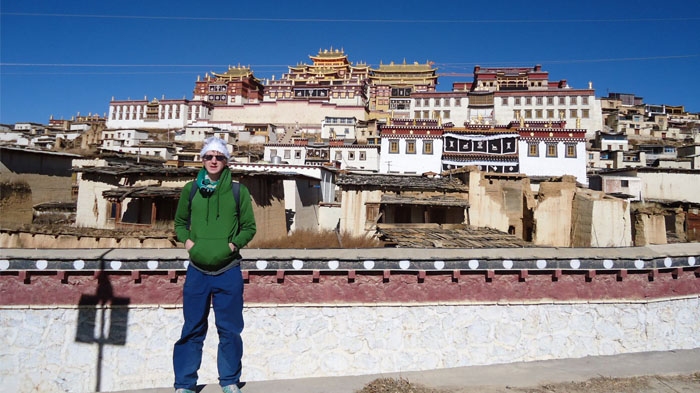
Shangri-La Tibet Town: where is Shangri La and Shangri La City in China?
Shangri La first appeared in the 1933 novel, Lost Horizon, by British author James Hilton. In the novel, Shangri La was the mythical paradise valley set somewhere in the western end of the Kunlun Mountain range in what is now Qinghai Province of China. A mystical and harmonious valley that was guided gently from the lamasery, the legend of Shangri La grew into a lost earthly paradise and a mythical utopia somewhere in the Himalayas, a land isolated from the rest of the world and impossible to find where people lived for hundreds of years.
In reality, Shangri La is a city in Yunnan Province in southwest China, located in Diqing County, which borders with Sichuan Province to the northeast and the Tibet Autonomous Region (TAR) to the northwest. Known locally in China as Xianggelila, the county-level city was formerly known as Zhongdian County, and was renamed after Hilton’s fictional paradise in 2001 to promote tourism in the Tibetan areas of Yunnan province. The capital of the Diqing Tibetan Autonomous Region in Yunnan, this beautiful area of southwest China is well worth visiting. The city was known to the Tibetan population of the area as Gyalthang, which means “Royal Plains”, which is still reflected in the Chinese name of the seat of Shangri La, Jiantang.
Top 5 Shangri-La Tibet Towns in Shangri La City
Shangri La is made up of five major towns in the area, including Jiantang Town, Zhongdian Town, Hutiaoxia Town, Jinjiang Town, and the Luoji Township. Shangri La is known for its unique Tibetan culture and the stunning alpine grasslands, high mountains, and spectacular gorges that can be found across the area. While there are more than 20 ethnic minorities in Shangri La, the majority are of Tibetan origin, and the Tibetan lifestyle and religion predominates the region, making it one of the ideal places to visit if you cannot get to the TAR.
Shangri La lies at an altitude of over 3,000 meters, and has a humid alpine plateau climate, with a regular, if short, monsoon season. The general climate of the city varies very little from one town to the other, though the temperature variations can be wide, ranging from heights of 26°C during the hottest summer days to as low as around 3°C in the depths of winter. On average, the temperature differential is around 13-16°C between day and night. And while the monsoon is apparent in the summer months from June to September, the wettest month only sees around 200mm of rain.
Zhongdian Town
Known more commonly as Zhongdian Old Town, this unique and ancient part of Shangri La is a fierce tangle of old wooden houses, with finely carved sculptures. Pedestrian streets run through the tangled web of erratic buildings, with no order or sense to them, leading visitors into the more remote areas of the town where the local Tibetan population still lives in the same way as their ancestors have for centuries. - Find out how to plan How to Plan a Shangri La Tour.
 Zhongdian Old Town is one of the must-visit towns in Shangri La.
Zhongdian Old Town is one of the must-visit towns in Shangri La.
The unique Tibetan village of wooden houses in Zhongdian Town is one of the most fantastic features of the area, and has kept its original charm and traditional architecture despite the march of progress on the main city further off in Shangri La. The paved streets, which are all pedestrianized, are often steep and arduous climbs, and it is easy to get lost in this warren of delicate wooden Tibetan homes. Even the roofs of the houses are made of wood, and the design of many of the houses is reminiscent of the western mountain cottages of the Alps.
The central square of this unique village comes alive in full swing in the evenings, with the people gathering in the square to enjoy the delightful sounds of traditional Tibetan music. Traditional dances are often performed by the local dancers and players, and it is common to see many of the women still wearing the traditional outfits of colorful turbans and long Tibetan skirts.
The maze of streets is also a haven for excellent little cafes and restaurants that specialize in sweet and butter tea and traditional Tibetan cuisine, including lots of yak meat. An awesome place to spend the afternoon, this relaxing area of Shangri La is the perfect rural setting in the midst of a large city.
Hutiaoxia Town
Lying on the Yangtze River in Shangri La, Hutiaoxia Town is also known as “Tiger Leaping Gorge Town”, and was formerly known as Qiaotou, or “Bridgehead”. Located at the southern end of the famous Tiger Leaping Gorge, hiking route, which starts in Lijiang, this small Chinese town is a great place to stop and rest, and perhaps dine, after the long hike up the gorge. A good number of cafes, restaurants, and guesthouses have appeared over the years as the hiking fever in southwest China has grown into a major tourist business.
 Tiger Leaping Gorge is a popular tourist destination for travellers located in Shangri-la.
Tiger Leaping Gorge is a popular tourist destination for travellers located in Shangri-la.
Tiger Leaping Gorge is a beautiful scenic canyon in Yunnan Province, through which the Jinsha River flows, a tributary of the Upper Yangtze. Part of the Three Parallel Rivers Protected World Heritage Site, the gorge drops up to 3,790 meters from mountain peak to river. This stunning gorge is known to be one of the deepest canyons in the world, as well as one of the most spectacular in terms of scenery and landscapes. The gorge is also home to the ancient Naxi people of southwest China, whose small villages are dotted through the gorge area. - Please feel free to email us to customize a Shangri La tour.
The gorge is formed between the two sacred mountains, Jade Dragon Snow Mountain (5,596m) and the Haba Snow Mountain (5,396m), through which the river runs in a series of fast-flowing rapids beneath the steep 2,000 meters cliffs. Legend says that a tiger jumped the river at its narrowest point to escape a hunter, and the name was given from that by the hunter who lost his quarry.
Jinjiang Town
Located on the upper reaches of the Jinsha River, Jinjiang Town is an area of Shangri La that has a much milder climate than the rest of the county-level city. The flat valley floor of the area, set between the protective mountains, means the weather is normally warmer in the summer and milder in the winter, protected from the colder winds from the north and the monsoon rains from the southwest. A major farming region of Shangri La, this verdant landscape is patterned with a patchwork of rice fields interspersed with copses of small trees and fringed along the hillsides with forests of pine trees.
 First Bend of the Yangtze River is one of the top attractions of Lijiang, Yunnan.
First Bend of the Yangtze River is one of the top attractions of Lijiang, Yunnan.
The First Bend of the famous Yangtze River lies with in Jinjiang, and is known as the First Bend as it is where the Yangtze rushes head on into the Hengduan Mountains and make a huge sweeping turn around the end of the mountain range to turn back north again. The town of Shiguzhen, at the bend of the river, is famous for being a major crossing point of the Jinsha River, and the crossing dates back more than 2,300 years. It is said Zhuge Liang crossed the river here with his army, and that the Mongolian Emperor, Kublai Khan also used this crossing in the 13th century to attack the town of Dali. It is also the site at which the notorious Red Army crossed the river on the famous Long March, and there is a Red Army Memorial Hall in the town.
Jiantang Town
Jiantangzhen is the last remnant of the former Tibetan name of Shangri La, Gyalthang, and is one of the five small towns within the prefecture-level city. Lying to the southwest of the center of Shangri La, this small community sits on the southern edge of the huge Longtan Reservoir, and is a quaint village to visit.
 Sumtsaling Monastery is the largest Tibetan Buddhist monastery in Yunnan.
Sumtsaling Monastery is the largest Tibetan Buddhist monastery in Yunnan.
Jiantang is also the location of the largest Tibetan Buddhist monastery in Yunnan Province, known as the Sumtsaling Monastery or Guihua Monastery. Surrounded by small villages, forests of alpine pine trees, and high Hengduan Mountains, this beautiful monastery lies at an altitude of 3,300 meters and is known locally as the “little Potala Palace” because of the resemblance to Lhasa’s iconic landmark and the powerful position it holds in Yunnan. Built in 1679, the monastery was constructed on the orders of the fifth Dalai Lama, and was instrumental in supporting the Chinese troops against invading Japanese during World War II. Find out more popular Yunnan and Tibet tours.
Luoji Township
The last of the five towns in Shangri La, Luoji Township is located in the mountainous area in the east of Shangri La county-level city, to the east of Deqen town. A major agricultural center in Shangri La, this small township takes advantage of its rich fertile soils in the lower valleys, where rice, potatoes, corn, and wheat are the main crops.
 Capturing a bird's-eye view of the peaceful Luoji township in Shangri La.
Capturing a bird's-eye view of the peaceful Luoji township in Shangri La.
The township has more than 72 mountain peaks within its area, the highest being Mount Nengnabu at 4,495 meters above sea level. The mountainous area is a drier and colder climate area, with higher rainfall and milder weather to the northwest, along the Jinsha River Valley, the lowest point in the township at around 1,500 meters.
Much of the landscape around the township consists of forests of pine trees, and the area is prone to forest fires in the summer, though the forests are renowned for trekking and hiking trails. The township is also renowned for being one of the few places in China that grow and harvests a medicinal plant known as “chongcao”, a version of the Cordyceps sinensis or caterpillar fungus, which brings in a considerable income for the township. Most of these fungi are found higher up on the Tibetan plateau to the northwest.
Conclusion
Shangri La may have been renamed to promote tourism, but this mainly Tibetan area of Yunnan has plenty to boast about, with some of the most beautiful areas in Yunnan province under its small belt. From the stunning scenery of the Tiger Leaping Gorge to the relaxed atmosphere of the Zhongdian Old Town’s wooden houses and narrow web of streets, Shangri La is well worth taking time to visit.

I am a tour guide in Tibet an was Born in Kham Tibet, I am the father of 2 little girls, bachelor's degree. I have more than 7-years experience of being a tour guide in Tibet. I am a warm, friendly, knowledgeable and attractive guy.


.jpg)


0 Comment ON "Shangri-La Tibet Town: where is Shangri La and Shangri La City in China? "